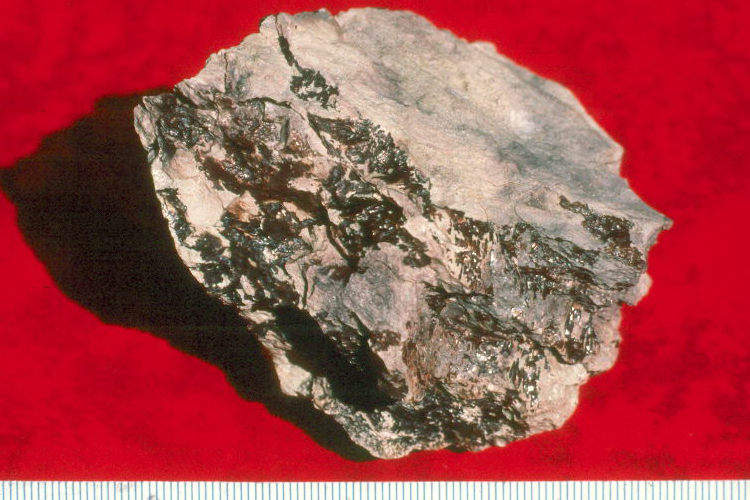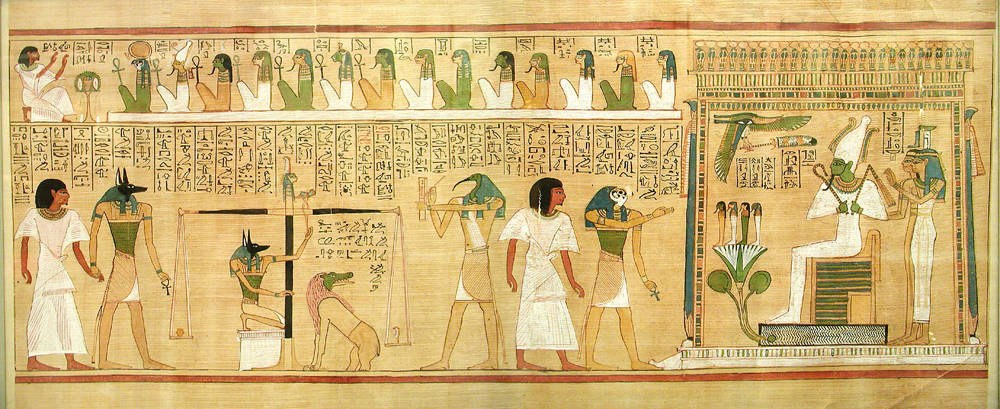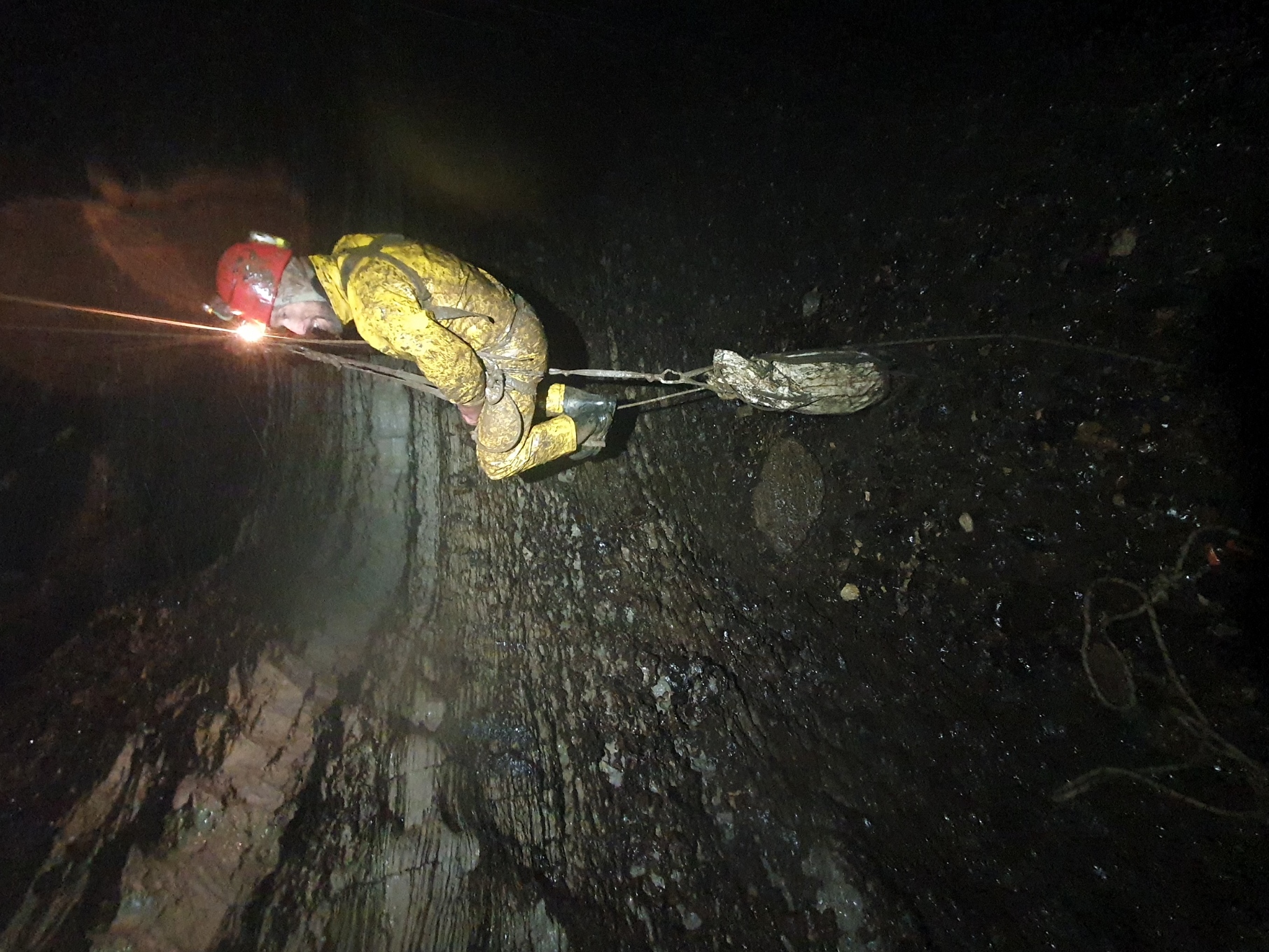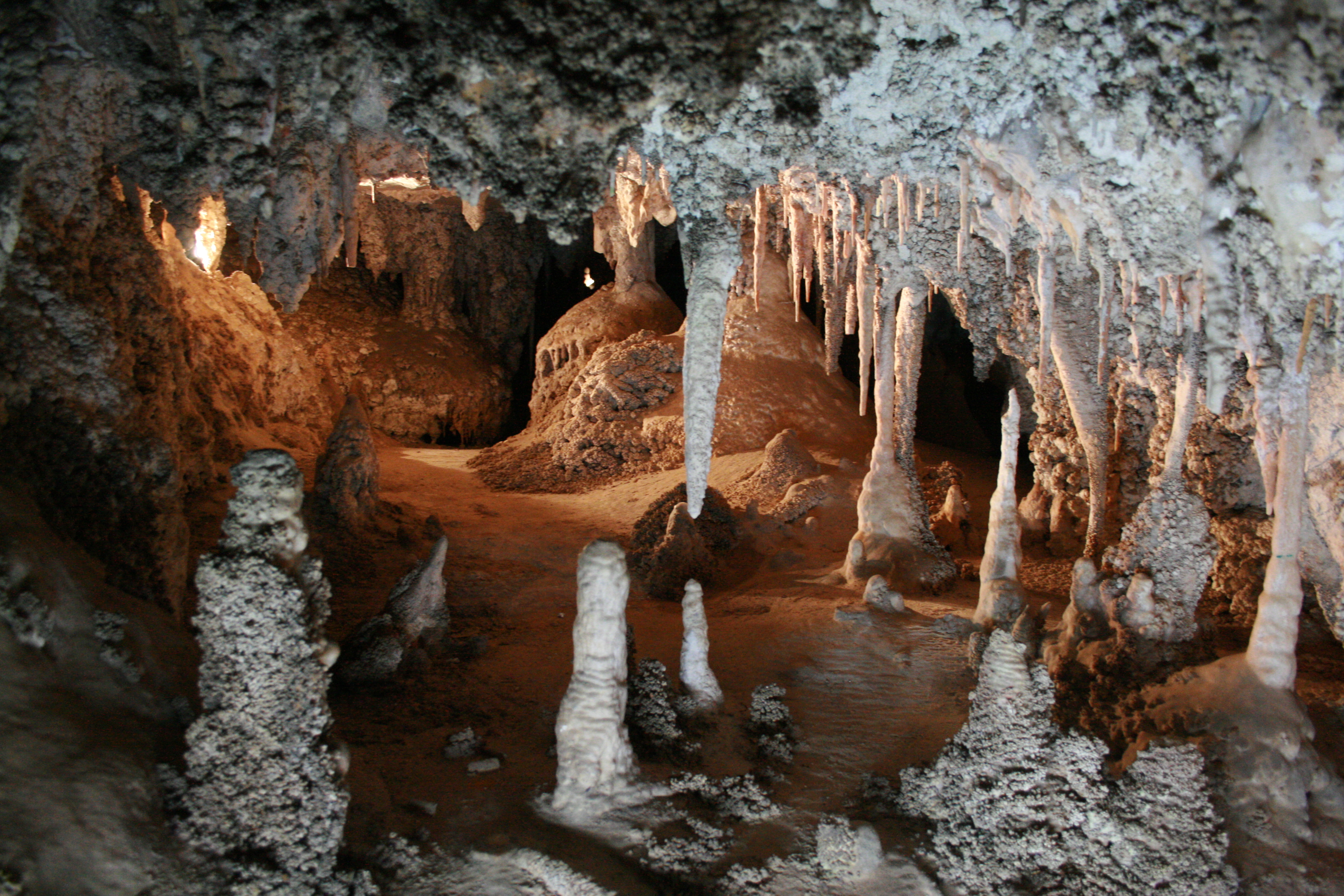|
Ngilgi Cave
Ngilgi Cave, previously known as Yallingup Cave, is a karst cave to the northeast of Yallingup, in the southwest of Western Australia. In many sections of the cave a red layer of soil can be seen; this is called paleosol. Discovery The local Wardandi people have long known of the existence of the Ngilgi cave. The Wardandi believe the caves to be their passage to the afterlife. Edward Dawson was the first European to enter the cave when he went searching for stray horses in 1899. He acted as a guide to the cave from December 1900 to November 1937. It was frequently promoted and was highlighted in early twentieth century tourism promotion materials. Naming It was originally named for the nearby town of Yallingup but later renamed to acknowledge the cave's part in Australian Aboriginal mythology. Ngilgi (pronounced Neelgee) was a good spirit who triumphed in battle against an evil spirit Wolgine. The story is part of the heritage of the Wardandi people who are the custodi ... [...More Info...] [...Related Items...] OR: [Wikipedia] [Google] [Baidu] |
Yallingup, Western Australia
Yallingup is a town in the South West (Western Australia), South West region of Western Australia, south of Perth, Western Australia, Perth. Yallingup is a popular tourist destination because of its beaches and limestone caves, and proximity to Leeuwin-Naturaliste National Park. History and industry Yallingup's name means "Place of caves" in the local Aboriginal Wardandi dialect, with "yal" meaning "large hole"; the name has been rumoured to mean "place of love" due to the popularity of weddings and honeymoons in the town. After its caves were discovered by European settlers in 1899, Yallingup became popular with tourists, and its early infrastructure was photographed by Amelia Bunbury, Coyarre. There was a state primary school in Yallingup from 1905 to 1963; the site now contains a Waldorf education, Steiner school. Around 1920, the Yallingup Hall, which was previously a school building in Karridale, Western Australia, Karridale, was moved to the townsite and reassembled. Touris ... [...More Info...] [...Related Items...] OR: [Wikipedia] [Google] [Baidu] |
Western Australia
Western Australia (commonly abbreviated as WA) is a state of Australia occupying the western percent of the land area of Australia excluding external territories. It is bounded by the Indian Ocean to the north and west, the Southern Ocean to the south, the Northern Territory to the north-east, and South Australia to the south-east. Western Australia is Australia's largest state, with a total land area of . It is the second-largest country subdivision in the world, surpassed only by Russia's Sakha Republic. the state has 2.76 million inhabitants percent of the national total. The vast majority (92 percent) live in the south-west corner; 79 percent of the population lives in the Perth area, leaving the remainder of the state sparsely populated. The first Europeans to visit Western Australia belonged to the Dutch Dirk Hartog expedition, who visited the Western Australian coast in 1616. The first permanent European colony of Western Australia occurred following the ... [...More Info...] [...Related Items...] OR: [Wikipedia] [Google] [Baidu] |
Karst
Karst is a topography formed from the dissolution of soluble rocks such as limestone, dolomite, and gypsum. It is characterized by underground drainage systems with sinkholes and caves. It has also been documented for more weathering-resistant rocks, such as quartzite, given the right conditions. Subterranean drainage may limit surface water, with few to no rivers or lakes. However, in regions where the dissolved bedrock is covered (perhaps by debris) or confined by one or more superimposed non-soluble rock strata, distinctive karst features may occur only at subsurface levels and can be totally missing above ground. The study of ''paleokarst'' (buried karst in the stratigraphic column) is important in petroleum geology because as much as 50% of the world's hydrocarbon reserves are hosted in carbonate rock, and much of this is found in porous karst systems. Etymology The English word ''karst'' was borrowed from German in the late 19th century, which entered German much earlier ... [...More Info...] [...Related Items...] OR: [Wikipedia] [Google] [Baidu] |
Karst
Karst is a topography formed from the dissolution of soluble rocks such as limestone, dolomite, and gypsum. It is characterized by underground drainage systems with sinkholes and caves. It has also been documented for more weathering-resistant rocks, such as quartzite, given the right conditions. Subterranean drainage may limit surface water, with few to no rivers or lakes. However, in regions where the dissolved bedrock is covered (perhaps by debris) or confined by one or more superimposed non-soluble rock strata, distinctive karst features may occur only at subsurface levels and can be totally missing above ground. The study of ''paleokarst'' (buried karst in the stratigraphic column) is important in petroleum geology because as much as 50% of the world's hydrocarbon reserves are hosted in carbonate rock, and much of this is found in porous karst systems. Etymology The English word ''karst'' was borrowed from German in the late 19th century, which entered German much earlier ... [...More Info...] [...Related Items...] OR: [Wikipedia] [Google] [Baidu] |
Yallingup
Yallingup is a town in the South West region of Western Australia, south of Perth. Yallingup is a popular tourist destination because of its beaches and limestone caves, and proximity to Leeuwin-Naturaliste National Park. History and industry Yallingup's name means "Place of caves" in the local Aboriginal Wardandi dialect, with "yal" meaning "large hole"; the name has been rumoured to mean "place of love" due to the popularity of weddings and honeymoons in the town. After its caves were discovered by European settlers in 1899, Yallingup became popular with tourists, and its early infrastructure was photographed by Coyarre. There was a state primary school in Yallingup from 1905 to 1963; the site now contains a Steiner school. Around 1920, the Yallingup Hall, which was previously a school building in Karridale, was moved to the townsite and reassembled. Tourism and viticulture are Yallingup's primary industries. Geography and climate Yallingup is located south of Perth and we ... [...More Info...] [...Related Items...] OR: [Wikipedia] [Google] [Baidu] |
Paleosol
In the geosciences, paleosol (''palaeosol'' in Great Britain and Australia) is an ancient soil that formed in the past. The precise definition of the term in geology and paleontology is slightly different from its use in soil science. In geology and paleontology, a paleosol is a former soil preserved by burial underneath either sediments (alluvium or loess) or volcanic deposits (volcanic ash), which in the case of older deposits have lithified into rock. In Quaternary geology, sedimentology, paleoclimatology, and geology in general, it is the typical and accepted practice to use the term "paleosol" to designate such "''fossil soils''" found buried within sedimentary and volcanic deposits exposed in all continents. In soil science the definition differs only slightly: ''paleosols'' are soils formed long ago that have no relationship in their chemical and physical characteristics to the present-day climate or vegetation. Such soils are found within extremely old continental cra ... [...More Info...] [...Related Items...] OR: [Wikipedia] [Google] [Baidu] |
Wardandi
The Wadandi, also spelt Wardandi and other variants, are an Aboriginal people of south-western Western Australia, one of fourteen language groups of the Noongar peoples. Name There are at least three theories about the meaning of the tribal ethnonym. One informant suggested it reflected a word for "crow" (''wardan''), a theory that sits poorly with early word lists that state that the Wardandi word for that bird is ''kwa:kum''. A second view argues for the sense of "seacoast people"; one source in support of this cites a word variously given as ''waatu'' or ''waatern'' with the meaning "the ovean ". A third hypothesis has it that the name is derived from the word for "no". Country Wadandi traditional country covers an estimated . Predominantly coastal, it encompasses Busselton and the areas from Bunbury to Cape Leeuwin and Geographe Bay. Inland it reaches the area around Nannup. They were the sole inhabitants of the area for an estimated 45,000 years before the arrival of ... [...More Info...] [...Related Items...] OR: [Wikipedia] [Google] [Baidu] |
Afterlife
The afterlife (also referred to as life after death) is a purported existence in which the essential part of an individual's identity or their stream of consciousness continues to live after the death of their physical body. The surviving essential aspect varies between belief systems; it may be some partial element, or the entire soul or spirit of an individual, which carries with it and may confer personal identity or, on the contrary, nirvana. Belief in an afterlife is in contrast to the belief in oblivion after death. In some views, this continued existence takes place in a spiritual realm, while in others, the individual may be reborn into this world and begin the life cycle over again, likely with no memory of what they have done in the past. In this latter view, such rebirths and deaths may take place over and over again continuously until the individual gains entry to a spiritual realm or otherworld. Major views on the afterlife derive from religion, esotericism an ... [...More Info...] [...Related Items...] OR: [Wikipedia] [Google] [Baidu] |
Sunday Times (Perth)
''The Sunday Times'' is a tabloid Sunday newspaper published by Western Press Pty Ltd, a subsidiary of Seven West Media, in Perth and distributed throughout Western Australia. Founded as The West Australian Sunday Times, it was renamed The Sunday Times from 30 March 1902. Owned since 1955 by Rupert Murdoch's News Corp Australia and corporate predecessors, the newspaper and its website ''PerthNow'', were sold to Seven West Media in 2016.SWM finalises purchase of The Sunday Times . '''', 8 November 2016, page 3 History Established by |
Australian Aboriginal Mythology
Australian Aboriginal religion and mythology is the sacred spirituality represented in the stories performed by Aboriginal Australians within each of the Aboriginal Australian languages, language groups across Australia in their Aboriginal ceremonies, ceremonies. Aboriginal spirituality includes The Dreaming, the Dreamtime (''the Dreaming''), songlines, and Aboriginal oral literature. Aboriginal spirituality often conveys descriptions of each group's local cultural landscape, adding meaning to the whole country's topography from oral history told by ancestors from some of the earliest recorded history. Most of these spiritualities belong to specific groups, but some span the whole continent in one form or another. Antiquity An Australian Linguistics, linguist, R. M. W. Dixon, recording Aboriginal myths in their original languages, encountered coincidences between some of the landscape details being told about within various myths, and Hard science, scientific discoveries bein ... [...More Info...] [...Related Items...] OR: [Wikipedia] [Google] [Baidu] |
Niggly Cave, Tasmania
Niggly/Growling Swallet cave system (JF-237), Tasmania is the deepest cave in Australia. Part of the extensive Junee-Florentine karst area near Mt Field National Park, it was considered to be the deepest explored cave in Australia since being discovered in 1994 until it was connected to and technically absorbed by the Growling Swallet (JF-36) system in 2019, bringing the depth record to 397m. The nearby Delta Variant Cave (JF-761) is expected to join the Niggly Cave/Growling Swallet system and push the depth record just over 400m in mid to late 2022. Recent exploration has been carried out by the Southern Tasmanian Caverneers - other deep caves they have explored nearby include Tachycardia Cave (JF-270). The entrance to Niggly Cave is somewhat uninspiring, immediately dropping down a tight vertical shaft, and interspersing tight horizontal passages with large and spectacular drops, the longest being 183m. After 250m of abseiling and squeezing, a large underground river is rea ... [...More Info...] [...Related Items...] OR: [Wikipedia] [Google] [Baidu] |
List Of Caves In Australia
This is a list of caves in Australia. Show caves New South Wales * Abercrombie Caves * Ashford Caves * Bendethera Caves * Borenore Caves * Bungonia Caves * Careys Caves * Cliefden Caves * Jenolan Caves ( List of caves within the Jenolan Caves karst) * Timor caves. Murrurundi.hunter valley * Tuglow Caves * Wee Jasper * Wellington Caves * Wombeyan Caves ** Fig Tree Cave ** Wollondilly Cave ** Junction Cave ** Kooringa Cave ** Mulwaree Cave ** Dennings Labyrinth * Wyanbene Caves * Yarrangobilly Caves Queensland * Capricorn Caves * Chillagoe-Mungana Caves ** Donna Cave ** Trezkinn Cave ** Royal Arch Cave South Australia * Kangaroo Island ** Kelly Hill Caves * Lower South-East ** Cave Gardens (Mount Gambier) ** Engelbrecht Cave ** Tantanoola Caves * Upper South-East ** Naracoorte Caves *** Alexandra Cave *** Blanche Cave *** Victoria Fossil Cave *** Wet Cave Tasmania * Gunns Plains Cave, Gunns Plains * Mole Creek ** King Solomons Cave ** Marakoopa Cave * Newdeg ... [...More Info...] [...Related Items...] OR: [Wikipedia] [Google] [Baidu] |

.jpg)





